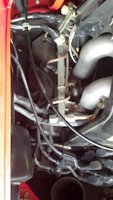1966 porsche cranks over well but no spark and sniffing exhaust like no fuel. What to check?
Engine cranks over well and fast but no spark while cranking and I don't get the raw gas smell from the exhaust. I did find that when set up for checking spark from the coil via the coil wire to the distributor, I get one spark when the key is turned on.
Where to look and what to look for?
12 Answers
Exactly what model is it? 912 or 911? Is it equipped with a Bosch CDI ignition, an MSD, or what? Mechanical FI, or Carbs? john
Okay, I went out and reviewed everything and even took some pictures. 1. It is a 1966 Porsche 911 2. It is a 6 cylinder 3. It is fuel injected, not carbureted. 4. It is not turbo charged 5. It does not have conventional breaker points in the distributor, it had electronic ignition 6. With both digital and analog volt meters, there is 12.39 volts supplied to the green wire on the coil as well as the black wire on the coil when the key is turned to the on or run position. When cranked, there is no pulsing of voltage. The voltage on both coil terminals drops to 10.3 volts while cranking. (I would expect to see the voltage to drop to zero and go back up, causing the coil field to collapse, thus firing the spark plugs. This is not the case, the voltage just drops two full volts while cranking and remains steady) 7. I examined all of the fuses in the fuse block in the left front trunk. All had full battery voltage on both sides (no corrosion or bad connection) except #6, the fuel pump. It only gets full battery voltage when the key is turned to the crank position. 8. The car is immaculate, no rust or corrosion anywhere and all of the electrical connections are extremely clean and ‘fresh’. 9. This is the engine that came with the car. 10. I have several pictures but don’t know how to forward them to you. I just saw the 'Add photo' below, pictures to follow...
Pictures of 1966 911, 6cylinder, fuel injected, electronic ignitioned Porsche:
It seems this will only let me post a single picture. Can I email them to you? I have four; one of the dist cap, one of the distributor (absent of points and breaker plate), one of fuel 'rail', and the one of injectors above.
That picture is of a later 3.2 left engine bank as used in 84-89 911 Carrera's....So you have a 66 911 with a 3.2, or you have an 86 911? Either way, the car would have a DME relay mounted beside the CPU, which if it's an 86 its under the drivers seat. Good chance it's the DME relay, or a crank sensor.
Okay, what action do I take on the DME relay? And, fyi, I was told it was 1966 and not wearing my 'aging' glasses for reading the first six must have looked like an eight. And now, thinking back, Porsche / VW didn't go to a 12 volt system until 1967, and this is definitely a 12 volt.
Here's a link to locate and repair your DME, however, I would just order a new one, and try it. If that doesn't work, you should be carrying a spare relay anyway.... Then the next likely is the crank sensor. The third in line is the actual CPU beside the relay. Was this car ever wet enough in the foot wells to support goldfish? http://www.dietersmotorsports.com/tech/2001/DME_relay_failure.htm
I shall do. The car is 'pristine', no water signs, rust, crud, truly new condition everywhere. I have a DME on order, will try and continue with suggestions if necessary. Great link, also. I shall closely examine the old relay.
Install new DME today, no change. Examined the crank sensors, about 3 o'clock on the case, drivers side. No signs of damage, heat, or having been disturbed. I also took apart the old DME relay as indicated in the link and all of the solder connections on the card were solid. Any more ideas?
You need to test the sensors....Here's a link to a good How-To video: http://www.youtube.com/watch?v=zeFOOcLSk60 john
Thanks! Great links. I won't be able to get to the car until Friday.
Crank sensors can be read with a rather low level DVOM, but it has to record data for playback, they generate a mV signal as I recall since they have a perm magnet and it is wrapped in wire inside. the passing mass on the engine interrupts or trips it, then you read a value, it happens quick and the record feature can allow you to review the result. They give you the switching your points once did, electrically. They are designed to be in proximity of the mass as it passes. That gap can affect the function. I dont know on a porsche, but I have had many a sensor of this variety. damage, or having any metallic build-up can affect them out of range in mV signal result.....hope these thoughts help

